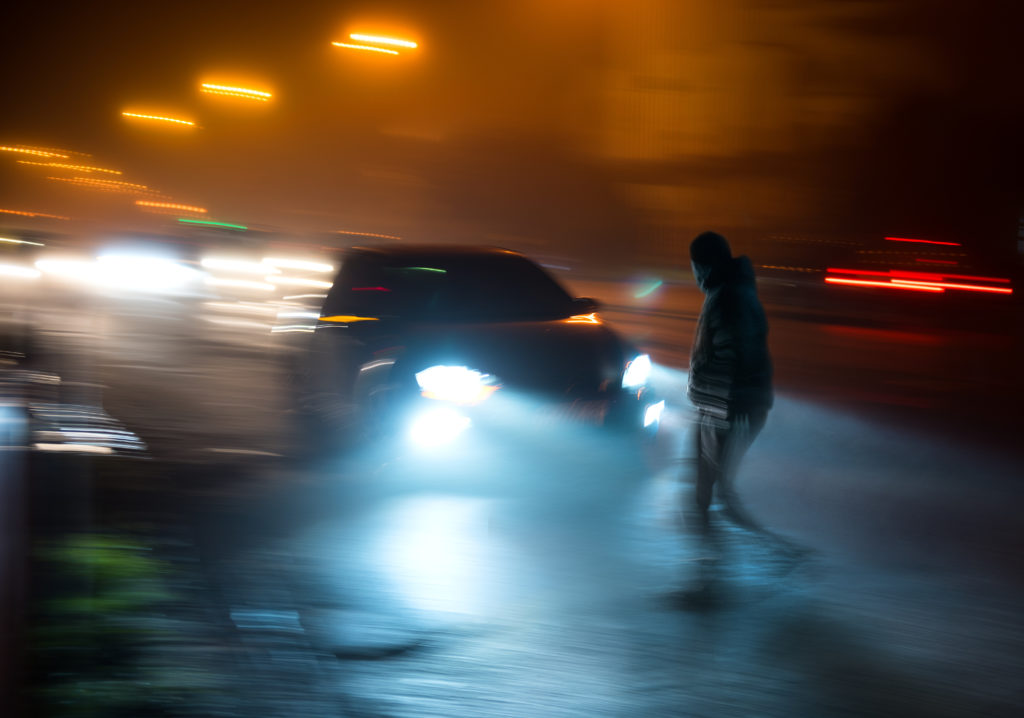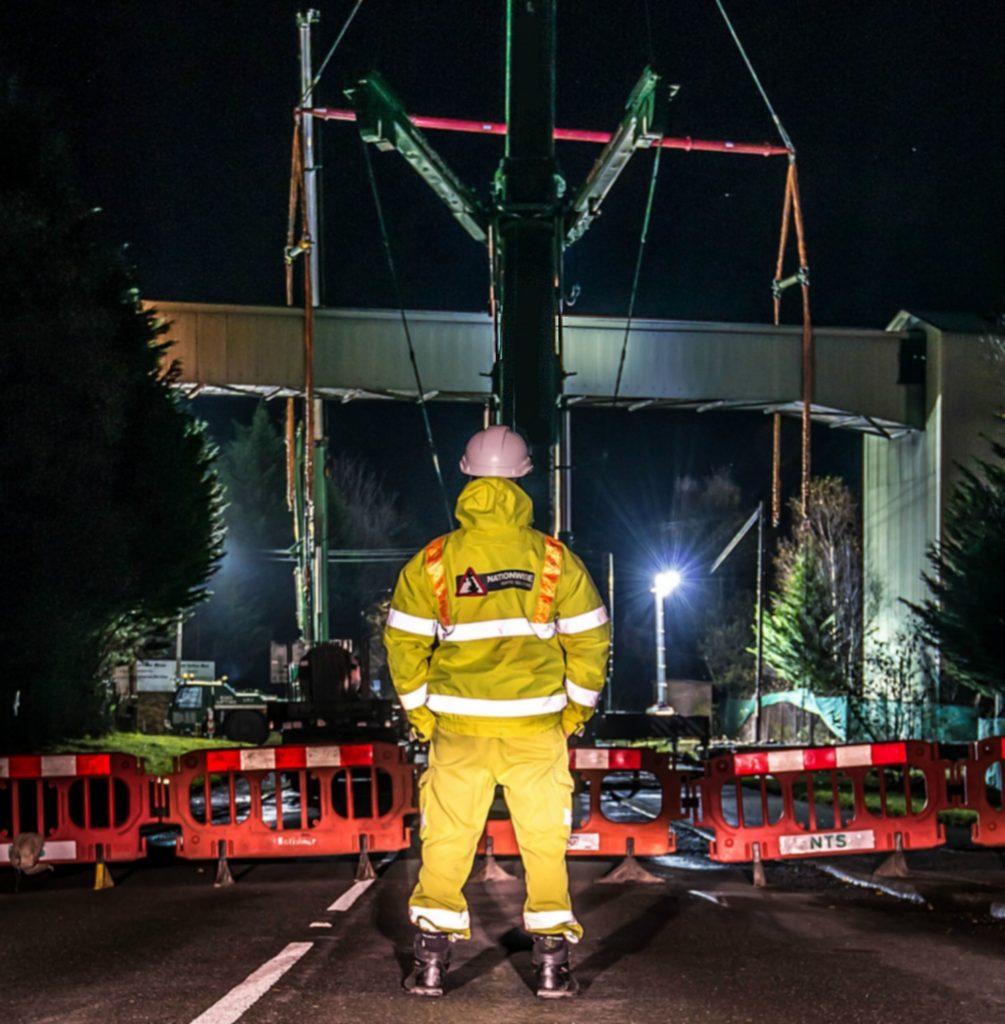Visibility aids, such as lighting, reflectors, and fluorescent material, are marketed to vulnerable road users (VRUs) like pedestrians and bicyclists as a way to enhance their safety on the road. These visibility aids increase the VRU’s contrast within the roadway environment therefore increasing their visibility. However, increasing visibility does not necessarily mean enhancing conspicuity. For example, the key difference between a visible pedestrian and a conspicuous pedestrian is that a visible pedestrian is distinguishable from their background whereas a conspicuous pedestrian “grabs” the driver’s visual attention. A visible VRU is visually ambiguous. The driver may see that “something” is ahead yet unaware of what that specific hazard is. From the point of view of a driver, the hazard could be trash, a mailbox, an animal, a child, etc. In contrast, a conspicuous VRU is easily recognizable as a VRU to a driver. Shortly after detecting a hazard, the driver is able to recognize what specific roadway hazard is present such as a child about to enter the roadway. With the recognition of the hazard, a driver is better able to take the appropriate actions in order to avoid the hazard. For example, a driver does not need to immediately brake when there is a mailbox ahead since the mailbox is not going to enter the roadway and cross paths with the driver. However, if a pedestrian is moving toward the roadway, the driver needs to take specific actions in order not to collide with the pedestrian.

A pedestrian that lacks contrast therefore visibility with the surrounding environment is less likely to be detected by a driver. In order to be conspicuous (i.e. recognizable) to a driver, pedestrians can highlight their movement.
When increasing VRU conspicuity and safety, it is vital to consider the best placement of the visibility aid on the body of the user. Here, the concept of biological motion (or biomotion) is key. Humans are able to perceive other humans based solely on their pattern of movement (biological motion) even if that pattern of movement is the only available visual information. Humans are perceptually sensitive to the movement of other human beings, such that when a biomotion stimulus is moving, a human’s visual attention will be automatically oriented to it above any other type of movement. For example, this concept can be applied to pedestrian safety by encouraging vulnerable road users to capitalize on a driver’s perceptual sensitivity and use visibility aids to highlight their own biomotion. This can be accomplished by placing the appropriate visibility aid on a pedestrian’s major joints such as their shoulders, elbows, wrists, hips, knees, and ankles. In doing so, the pedestrian’s biomotion will be highlighted and their conspicuity will be increased.

Highlighting the major joints of a VRU capitalizes on a driver’s perceptual sensitivity to biomotion. Image credit: https://www.nationwidetrafficsolutions.co.uk/roadworker-night-safety-tips/
In fact, past research indicates that visibility aids are more effective when placed on a pedestrian’s major joints than when the same visibility aids are centered on the pedestrian’s torso (See Tyrrell et al 2016 for review). This demonstrates that simply making a pedestrian visible (i.e. increasing their contrast) may not be sufficient to enhancing safety but increasing a pedestrian’s conspicuity via highlighting biomotion is key. Highlighting a pedestrian’s biomotion makes the pedestrian more easily recognizable by an unsuspecting driver. Through highlighting biomotion, pedestrians can be detected and recognized sooner in a driver’s approach, therefore providing more time for a driver to appropriately react to them.
While increasing the visibility of a pedestrian within a roadway environment is important, it is only the first step in making VRUs safer. VRU can capitalize on a human’s perceptual sensitivity to biomotion through increasing their conspicuity. Placing visibility aids on the major joints of a pedestrian (i.e. highlighting the pedestrian’s biomotion) increases a VRUs conspicuity. Increased VRU conspicuity can help a driver detect and recognize a potential hazard faster and sooner, therefore providing more time for the driver to best avoid the hazard.
Dr. Ellen Szubski, Ph.D, CXLT, CPSI, is a human factors consultant at The Warren Group. She has a Doctorate of Philosophy in Human Factors Psychology and a Master of Science in Applied Psychology from Clemson University. She did her dissertation on “The Influence of Pedestrian Biological Motion on Time-To-Collision Estimates at Night”. She is also a Certified XL Tribometrist and a Certified Playground Safety Inspector. Prior to entering the forensic field, Ellen planned and conducted experiments for a major bicycle manufacturer. She also conducted laser strike perception studies for the Department of Defense. Ellen applies her experience in Human Factors to the analysis of crash investigations and other personal injury matters. These matters often include collisions involving vulnerable road users and drivers, driver distraction, and slips, trips, and falls. She utilizes her knowledge of OSHA regulations, codes, and standards in her analysis of premises liability incidents and safety consulting. Ellen is a current member of the Human Factors and Ergonomics Society (HFES) and it’s Forensic Professional Technical Group.



